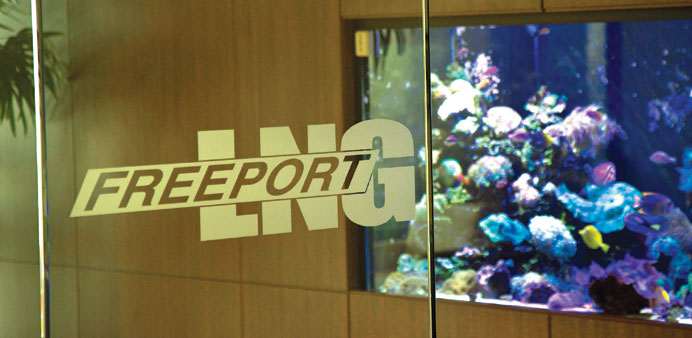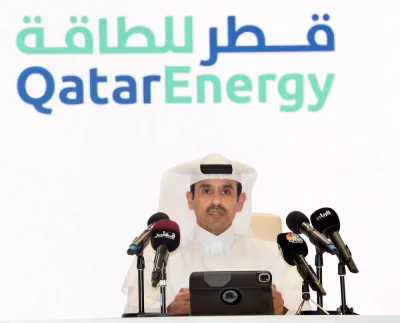Freeport LNG Development signage is displayed on the door of the company’s office in Houston, Texas (file). The Department of Energy has so far received applications on behalf of 24 projects to be allowed to export up to 32.4 bcf/d, nearly three times as much as contemplated in the high NERA scenario.
By John Kemp/London
Based on regulatory approvals so far and sales contracts already signed, the US will export much more liquefied natural gas (LNG) by the end of the decade than most analysts thought possible even a year ago.
In late 2011, the US Department of Energy commissioned NERA Economic Consulting to study the impact of exports on the US economy under a number of scenarios.
NERA was asked to analyse the effects of LNG exports limited to a relatively low level (6bn cubic feet per day) or a high one (12 bcf/d), with exports ramping up to full volume slowly (1 bcf/d per year) or rapidly (3 bcf/d per year). NERA was also asked to examine the case in which there was no limit on the volume of gas exported.
Publishing its finding in December 2012, NERA found there would be a net benefit to the economy under all scenarios, and the more LNG exported the bigger the net benefit would be.
“Scenarios with unlimited exports always had higher net economic benefits than corresponding cases with limited exports,” NERA concluded.
While NERA argued unlimited exports would be best for the economy, the inclusion of the 6 bcf/d and 12 bcf/d scenarios strongly implied the government thought volumes would be in this range, and perhaps should be limited to it through the approval process.
However, the Department of Energy has so far received applications on behalf of 24 projects to be allowed to export up to 32.4 bcf/d, nearly three times as much as contemplated in the high NERA scenario.
With the approval of an application from Dominion Cove Point on Wednesday, the department has now approved four projects, authorising them to export up to 6.37 bcf/d.
The pace of approvals is picking up. New approvals are coming at a rate of one every 6-8 weeks.
If this continues, the total volume is likely to breach the 12 bcf/d level by March 2014, raising questions about what criteria the department will use to decide which ones to approve and how many it intends to authorise in total.
In approving export applications the department recognises “the potential cumulative impact” according to its order approving Cove Point.
However, the assumptions that underpinned the department’s own export study and the economic study it commissioned from NERA already look out of date.
Senator Ron Wyden, chairman of the Senate Energy and Natural Resources Committee, who has opposed exports and questioned the findings in the earlier studies, has begun to sound the alarm.
Responding to the Cove Point approval, Wyden, a Democrat from Oregon, said: “With today’s approval, the US is now squarely in the range that experts are saying is the most likely level of US natural gas exports.”
“If the Department of Energy approves exports above that range, the agency has an obligation to use most recent data about US natural gas demand and production and prove ... that these exports will not have a significant impact on domestic prices and in turn on energy security, growth and employment,” he added in a statement.
Some observers doubt whether all of these projects will be built. But of the four projects already approved, three have signed firm contracts with overseas buyers for all their capacity. Two other projects which have not yet received formal approval have also already contracted their capacity.
In total, would-be LNG exporters have signed firm contracts to export 4.7 bcf/d (34mn tonnes per annum).
Counterparties who have agreed to buy exported LNG include established customers like BG Group, Total, BP, Centrica, Sumitomo, Osaka Gas, Chubu Electric Power, the Gas Authority of India and Korea Gas Corp
Cheniere Energy’s Sabine Pass Liquefaction project, which is the most advanced, has already awarded engineering, procurement and construction (EPC) contracts for four LNG trains to Bechtel. Trains 1 and 2 are schedule to be completed in 2015-16. Trains 3 and 4 will be finished by 2016-17.
Cheniere has already sold output from two more production units, Trains 5 and 6, and just needs regulatory approval. Cheniere hopes to award EPC contracts for both trains in the second half of 2014.
Freeport LNG’s projects is less advanced, but has awarded a front-end engineering design (FEED) contract to Chicago Bridge & Iron and Zachry International, which is the last and most expensive piece of work before making a final investment decision (FID) to proceed.
Cove Point, which only got the final go ahead from the Department of Energy on September 11, had already awarded an EPC contract to IHI Engineering & Construction and Kiewit, according to the company’s website, with an in-service date of 2017.
If the department continues to process applications at the current rate and in the promised order, the next approvals will be for Freeport’s expansion project (1.4mn tonnes per annum), Sempra’s Cameron LNG (1.7 mtpa), Jordan Cove (0.8 mtpa), LNG Development Company (1.25 mtpa) and Cheniere Marketing (2.1 mtpa).
Most are big and established players in the gas industry, and most of these projects are highly likely to be built, taking exports above 12 bcf/d.
Eventual export volumes will depend on world demand, competing supplies developed in other countries and US domestic gas prices. Current worldwide LNG export capacity is around 37 bcf/d, with another 10 bcf/d already under construction or being planned.
“With additional projects in the planning stages in Qatar, Australia, Canada and elsewhere, the world may simply not need LNG from the US ... Consumers will have other options,” according to a study issued by Senator Lisa Murkowski in August. “The window for the US to join the global gas trade will not be open indefinitely,” Murkowski warned. “In fact it is narrowing, and there is a real possibility that the nation will miss out on a historic opportunity,” the study concluded.
Murkowski is the highest-ranking Republican on the Senate Energy and Natural Resources Committee, and a strong supporter of gas exports, and has called on the department to speed up its approval process. Murkowski’s home state of Alaska eventually hopes to host its own LNG export project to supply customers in Asia.
Approving Dominion Cove Point, the Department of Energy noted the total volume of exports so far approved “only modestly exceeds the 6 bcf/d volume evaluated by NERA.”
The department insisted it will continue taking a measured approach. “Specifically, the Department of Energy will continue to assess the cumulative impacts of each succeeding request for export authorisation,” according to the order.
The department claims it will attach “appropriate and necessary terms and conditions to the authorisations” and “other conditions will be applied as necessary.” Officials also claim the department can modify or rescind prior approvals, and issue supplemental orders if it finds necessary, under powers contained in Natural Gas Act.
This has led to enormous uncertainty about how many more export applications the department will approve, and in what circumstances it might modify or rescind some of them.
Despite their differing views, Wyden and Murkowski have joined together to ask the department to clarify the circumstances in which it would modify of revoke applications that have already been granted in a letter to Secretary of Energy Ernest Moniz.
Among the questions they want the department to answer is what factors it would consider in deciding whether to suspend or revoke an export authorisation, and whether the cumulative impact of exports might be one of them, as well as what rights an exporter would have to challenge the decision.
In reality, once the department has given its approval, it is hard to see any circumstances under which the permission could be rescinded.
John Kemp is a Reuters market analyst. The views expressed are his own.



